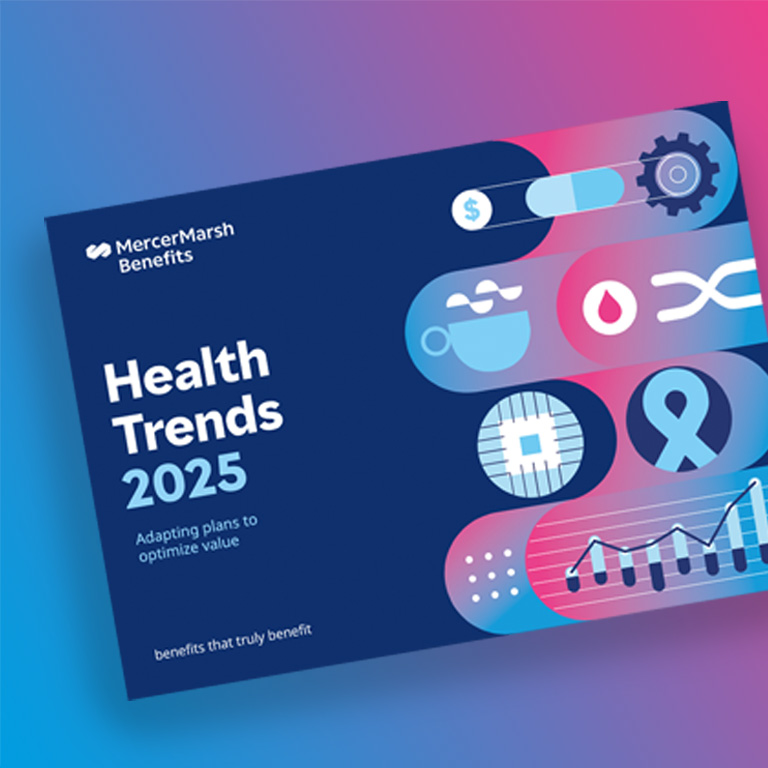
Dr. Patricia Lopez
Workforce Health Leader, Mercer Marsh Benefits Spain
-
Spain
Diversity of thought and experience are critical for business success. Yet our Health Trends 2024 research shows that employers often miss the mark when it comes to providing healthcare benefits that meets the needs of the entire workforce. Notably, there are worrying gaps in benefits for women, ethnic minorities and those suffering from poor mental health.
Although insurers are making strides in improving their offerings, there’s still work to be done. Employers should seize the day and use data and analytics to identify gaps in coverage, and encourage insurers to create solutions that embrace inclusivity and benefit all employees.
Our Health Trends 2024 research found that more than half of insurers globally (59%) offer regular training for plan member services teams to increase cultural competency. The same number have taken steps to ensure plan member communications are accessible and inclusive for all, including people with disabilities.
Product offerings are also becoming more inclusive:
It’s also encouraging to see that 31% of insurers globally are considering adding diagnosis, learning assistance or occupational therapy to support neurodiversity (although only 18% of European insurers are considering doing so).
However, insurers are less committed to making sure their wider ecosystem of medical network partners are diverse, with almost one-third (29%) saying they don’t address this and have no plans to do so.
Health-related disparities based on race and ethnicity are well documented, but it’s rare for insurers to use data to help address these inequities, and plans to put data to greater use are muted at best. Globally, 57% of insurers say they have no plans to use data in this way. In Europe, in particular, there is little appetite for data collection (likely due to the regulatory environment), although more insurers in Asia, the Middle East and Africa are considering introducing such analysis. While this data can enable quantification of disparities and document progress overtime, there is the potential for this data can also exacerbate discrimination or other create other harm if not protected appropriately.*
* National Research Council (US) Panel on DHHS Collection of Race and Ethnic Data. Appendix D, The Role of Racial and Ethnic Data Collection in Eliminating Disparities in Health Care. Available from ncbi.
Our research shows that mental health remains a blind spot for many businesses, and that coverage from medical insurers is still less consistent in this area than in others.
Companies should to wake up to the growing mental health crisis across the globe, which escalated during the COVID-19 pandemic. The impact of poor mental health on business can be significant. Among the potential consequences are sickness absence, disability claims, direct medical claims, poor morale and employee engagement, and colleague irritability or inability to cope at work. Ultimately, businesses that prioritise mental health will attract and retain top talent, while those that don’t may find they’re no longer employers of choice.
The top mental health-related benefits offered by insurers focus on traditional services, such as psychological and/or psychiatric counselling sessions (69%), inpatient treatment (62%), and coverage for medications prescribed for mental health (57%).
However, there is evidence of new and innovative solutions on the horizon. Virtual mental health counselling is already growing in popularity, with 48% of insurers saying this is available through their plans. A further 49% offer education, resources and tools for improving mental health in the areas of self-care, anti-stigma, mindfulness, and resilience.
Insurers are also including greater coverage for targeted services to support youth mental health, socialisation and learning — a top area of need identified by employees in our survey.
Our Health on Demand research asked employees which mental health benefits were most important to them. When we compare this data to the services insurers are either currently offering or planning to offer, we found worrying gaps:
Substance-abuse treatment is another area of mental health services with inadequate coverage, with 35% of insurers saying they don’t offer it and have no plans to do so.
Most worrying, few plans provide meaningful support for employees who need ongoing therapy. Although 69% of insurers globally say they cover psychological and/or psychiatric counselling sessions, in practice, 52% of those only cover 10 sessions or fewer.
Women’s health issues are universal, with significant social and financial disparities and health system inequalities to address in all regions.
Coverage for women’s health benefits remains sporadic and varies across geographies as our research Health Trends 2024 shows. For example, 64% of insurers in Asia do not offer contraception access, compared to only 33% that lack this offering in Latin America and the Caribbean.
The same research shows almost a quarter (24%) of insurers globally do not provide postpartum care, leaving women to either receive the care through the public system or not at all.
Other key gaps in employer-sponsored group medical insurance include fertility treatment, breastfeeding support and equipment, family planning, menopause support, and abortion access.
Employers looking to address gender equity in the workplace should evaluate social and financial disparities, health system bias, and family health decision-making, and caregiving expectations to establish where women’s needs are not being met. This includes provisions to address the following health concerns:
Employers that want to succeed in addressing inclusion gaps should ensure their benefits programs meet the needs of all their employees. Companies should therefore examine their current offerings to identify inequities. Once gaps are identified, firms should to work with their brokers to identify insurance partners that are breaking the mold, delivering innovative solutions that put inclusion front and center.
Make sure you understand what your employees want rather than making assumptions, and look for providers that can deliver. For a step-by-step guide, download our Health Trends 2024 survey report.

Workforce Health Leader, Mercer Marsh Benefits Spain
Spain

Wellness, Health & Claims Director, MMB

Article
13/10/2024